Content
There is at least a small bed of strawberries on almost any garden plot. This berry is extremely popular with gardeners all over the world. There are many old and "time-tested" varieties, the advantages and disadvantages of which are well known. But every year there are interesting promising novelties. Among them is the Brighton strawberry, which, thanks to its merits, has already gained many fans in a short time.
Breeding history
Brighton strawberry is an achievement of breeders from the USA. It appeared at the beginning of the XXI century. Following the "trends" of that time, experts created a remontant variety of neutral daylight hours, capable of abundantly bearing fruit in a temperate climate. But the practice of cultivation has proven that it belongs rather to the category of semi-renovated.
Russian gardeners "got acquainted" with Brighton strawberries 10 years later than American ones. The variety has successfully passed certification, but is still not listed in the State Register of Breeding Achievements of the Russian Federation. Nevertheless, he successfully "took root" in the private plots of Russian gardeners, adapting to a more severe than temperate climate.
Description of the Brighton strawberry variety and characteristics
After reviewing the description of the Brighton remontant strawberry variety, it is easy to understand why it relatively quickly managed to gain popularity among gardeners around the world.
Characteristics of fruits, taste
Peduncles bend under the weight of large berries. Their average weight is 50-60 g, there are some "champions" weighing up to 80 g. The shape is typically "strawberry", round-blunt-conical. The closer to the end of the fruiting period, the more the size and shape of the berries varies. There are also relatively small (20-30 g), and elongated, and almost spherical, and ribbed specimens.
The skin is glossy, evenly colored dark red, without a white "spot" at the stalk. The flesh is reddish-pink, very firm, as if "crispy", not particularly juicy. Brighton strawberry tastes like a cross between wild strawberry and pineapple. Light sourness definitely makes it more interesting, because not everyone likes fresh sweetness. Berries also have a light "strawberry" aroma.
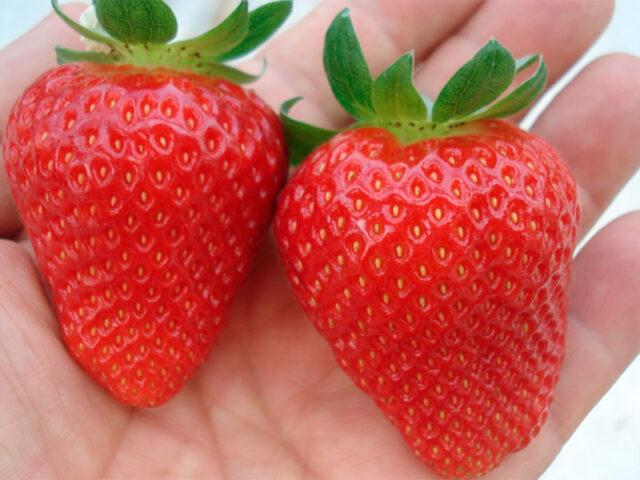
Brighton strawberry skin is thin, but strong enough
This is a versatile variety. Brighton strawberries are not only eaten fresh, but also canned for the winter, frozen, used as a filling for baking. After heat treatment and exposure to low temperatures, it retains a bright color, recognizable taste and shape.
Ripening terms, yield and keeping quality
Brighton strawberry belongs to varieties of neutral daylight hours, its duration does not affect yield. Therefore, when grown indoors, the bushes bear fruit for 10-11 months a year. When planting on open beds, the duration of fruiting depends on the characteristics of the local climate.
In central Russia, the first berries ripen in early June, in the Urals, in Siberia - 10-15 days later. The harvest is removed until the fall. In warm southern regions, Brighton strawberries bear fruit from late April or early May until the first frost.
From an adult bush when grown in the open field, 600-800 g of berries are removed per season. In especially good seasons - up to 1 kg.

Brighton strawberries are quite compact, "squat" bushes, not particularly densely leafy
The density of the pulp of the Brighton strawberry provides it with a very good keeping quality for this berry. At room temperature, it will not deteriorate within 2-3 days. Under optimal conditions, the berries retain their "presentation" and taste for a week and a half. They differ not only in keeping quality, but also in good transportability. Strawberries carry long distances without damage.
Growing regions, frost resistance
Brighton strawberries were created by breeders for cultivation in temperate climates. The bushes are able to overwinter without harming at temperatures up to - 20-25 ºС, even if they do not provide shelter.
However, the practice of growing this variety in Russia has proven that it can adapt to more severe climatic conditions. Brighton strawberries bear fruit steadily in the Urals, Siberia, and the Far East. Although here it, of course, needs to be protected from the cold.
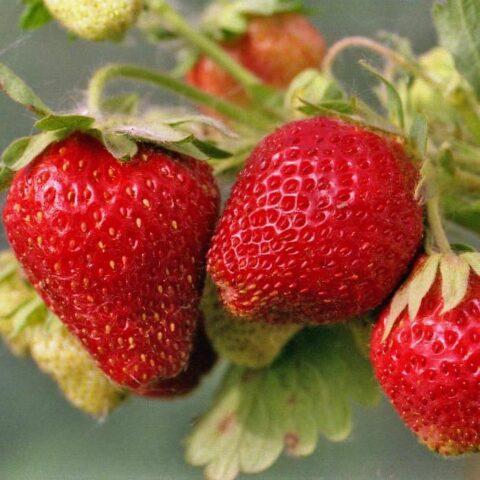
You can not count on record harvests of Brighton strawberries in far from optimal conditions
Disease and pest resistance
Breeders have provided Brighton strawberries with "innate" immunity against fungal diseases, including all types of spotting and gray rot. The only exception is root rot. But in its development, in the vast majority of cases, the gardener himself is to blame, being overly zealous with watering. If you follow the recommendations regarding agricultural technology, the risk of developing root rot is minimized.
Brighton strawberries are also not particularly interesting to pests. Often they bypass it, even attacking the bushes of other varieties growing in the garden. The only exception is the spider mite.
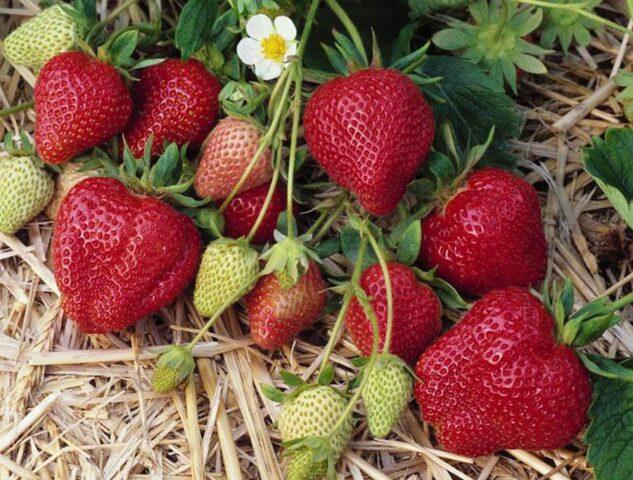
The first fruits of Brighton strawberry are one-dimensional and almost identical in shape, the latter cannot be said
Advantages and disadvantages of the variety
The undoubted advantages of Brighton strawberries include:
- good cold resistance even for Russia;
- endurance, allowing you to adapt to not always favorable climatic and weather conditions (and not only to survive, but also to bear fruit);
- unpretentious care - Brighton strawberries mainly require standard agricultural technology;
- the presence of immunity to almost all fungal diseases;
- suitability for growing not only in open ground, but also in greenhouses, both for personal consumption and on an "industrial scale" (it can also be cultivated on window sills, balconies);
- compactness of plants, which saves space in the garden;
- a relatively small number of leaves, such bushes are easier to care for, they are better blown by the wind, which reduces the risk of pest attacks;
- large-fruited, presentable appearance, excellent taste of berries;
- the versatility of strawberries, their keeping quality and transportability;
- long fruiting period, as a result - high yield.
It was not possible to identify significant shortcomings in Brighton strawberries. However, it should be taken into account that, despite the ability to withstand "interruptions" with irrigation, the variety is not drought-resistant. With a regular moisture deficit, the yield decreases sharply, the quality of the berries deteriorates.
Another nuance is the tendency to active mustache formation. If they are not removed in a timely manner, the Brighton strawberry bushes simply will not have the "strength" to ensure the ripening of the crop.
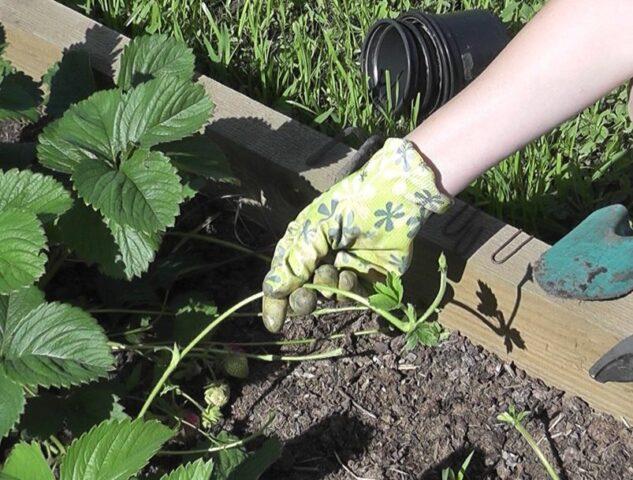
When growing Brighton strawberries, the mustache will have to be trimmed every 2-3 weeks.
Reproduction methods
Brighton strawberries are very active in forming a mustache.Therefore, it is propagated in this way, provided by nature itself. The gardener will definitely not have to face a shortage of planting material.
For reproduction, several "uterine" bushes are selected in advance - two-year-old, healthy, abundantly fruiting. During the spring, all the buds are cut off on them. Whiskers begin to form by June. Of these, you need to leave 5-7 of the most powerful.
The largest rosette is the first from the mother plant. But if you need to multiply Brighton strawberries quickly, use the second one on each mustache. As soon as roots about 1 cm long are formed on them, they, without separating from the bush, are either "pinned" to the soil, or planted in small pots, cups.
12-15 days before transplanting new specimens to a permanent place, the mustache is cut off. The procedure is planned for the end of July or August. In warm southern regions, you can transplant until October.
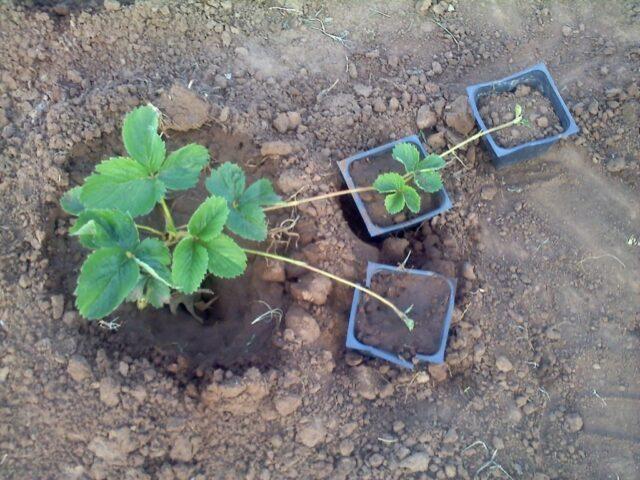
If you plant a mustache in peat cups, new plants will not have to be removed from containers during transplantation.
Planting and leaving
The Brighton variety has standard requirements for any strawberry planting site. And it is better to "listen" to them, wishing to collect bountiful harvests every year. In terms of agricultural technology, there are several important nuances, but caring for the plants will not take a lot of time and effort from the gardener.
Since Brighton strawberries are grown mainly in temperate climates, they are planted mainly in the spring. The optimal time is the second half of May or early June. It is necessary to wait until the risk of return frost is minimized.
A place for a garden with Brighton strawberries is chosen taking into account the following criteria:
- open space, well lit and warmed by the sun;
- availability of protection from strong gusts of cold winds, drafts;
- a substrate that allows water and air to pass through well, but at the same time is quite nutritious - loose loam, sandy loam;
- neutral or slightly acidic acid-base balance of the soil - pH 5.5-6.0;
- relatively deep, about a meter, groundwater lying under the soil surface (if there is no other place, you will have to fill a bed with a height of at least 0.5 m).
Brighton strawberries absolutely do not tolerate stagnant water at the roots. This further increases the risk of developing root rot. Plants will not take root in very "heavy" or overly "light" soil. Other unsuitable places for the garden include steep slopes and lowlands.
It is necessary to moisten the soil in the Brighton strawberry garden relatively often, but in moderation. If it is not too hot outside, once every 4-5 days is enough (the norm for an adult bush is about 3 liters). In extreme heat and in the absence of precipitation, the intervals are reduced to 2-3 days.
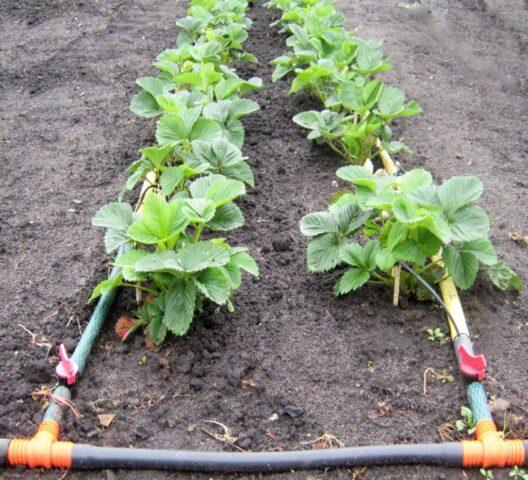
The method of watering for Brighton strawberries is not fundamental, but it is better that water drops do not fall on leaves, flowers and fruits
A long fruiting period and a relatively high yield provide the need for Brighton strawberries for intensive feeding. Fertilizers are applied four times during the growing season:
- in mid-April, almost immediately after the snow melts;
- at the stage of mass bud formation;
- at the end of June, after the harvest of the "first wave";
- 2-3 weeks after the end of fruiting.
The first feeding is necessarily nitrogen-containing fertilizers. They are necessary for the active formation of green mass. It can be both mineral feeding and natural organic matter. Next, store products designed specifically for strawberries are added. They provide plants with all the substances necessary for the ripening of berries, in the required amount.
Not necessary, but very useful agrotechnical measure for Brighton strawberries - mulching.This helps the gardener save time on weeding and loosening the garden, and also allows the shrub to be watered less frequently. It prevents the soil on the surface from "baking" into an air-tight crust and prevents rapid evaporation of moisture.
The best prevention of root rot is proper watering. It is also recommended to replace ordinary water 2-3 times a month with a pale pink solution of potassium permanganate or any fungicide of biological origin, reducing its concentration by half compared to that recommended in the instructions.

Root rot on the aerial part of the plant manifests itself when the process of development of the disease goes too far.
To protect against spider mites, onions, garlic are planted in the Brighton strawberry garden or the bushes are sprayed with shooters every 1.5-2 weeks. When characteristic thin, almost transparent "cobwebs" appear, entwining buds, young leaves, plants are treated with acaricides.
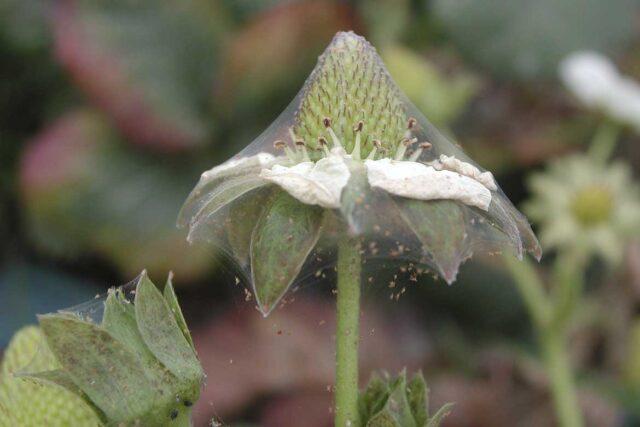
The spider mites themselves are very small, they cannot be seen with the naked eye
Preparing for winter
In southern regions with a subtropical climate, Brighton strawberries do not need shelter. Preparing bushes for winter is limited to trimming leaves and removing vegetable and other debris from the beds.
In a temperate climate in the middle of autumn, after clearing the garden bed, they renew the mulch layer or throw spruce branches. Humus is poured onto the bases of the Brighton strawberry bushes, forming "mounds" 8-10 cm high. If winter is predicted to be frosty and with little snow, it is advisable to additionally install arcs above the bed, pulling any covering material on them in 2-3 layers.
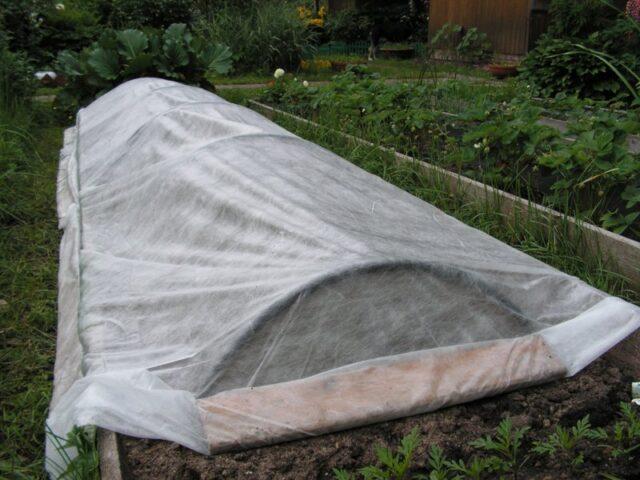
Preparing Brighton strawberries for winter depends on the climate in the region of its cultivation.
Conclusion
Brighton strawberries are semi-renovated varieties with neutral daylight hours. Among its undoubted advantages are taste, large size and external attractiveness of berries. Gardeners appreciate the compactness of the bushes, unpretentious care, the duration of fruiting. Of course, the variety cannot be called ideal, it has some disadvantages. But they do not spoil the overall picture.
Gardeners' reviews about Brighton strawberries
The description of the Brighton strawberry variety given by the breeders is confirmed by photos and reviews of gardeners. Most of the opinions about him are unambiguously positive.








